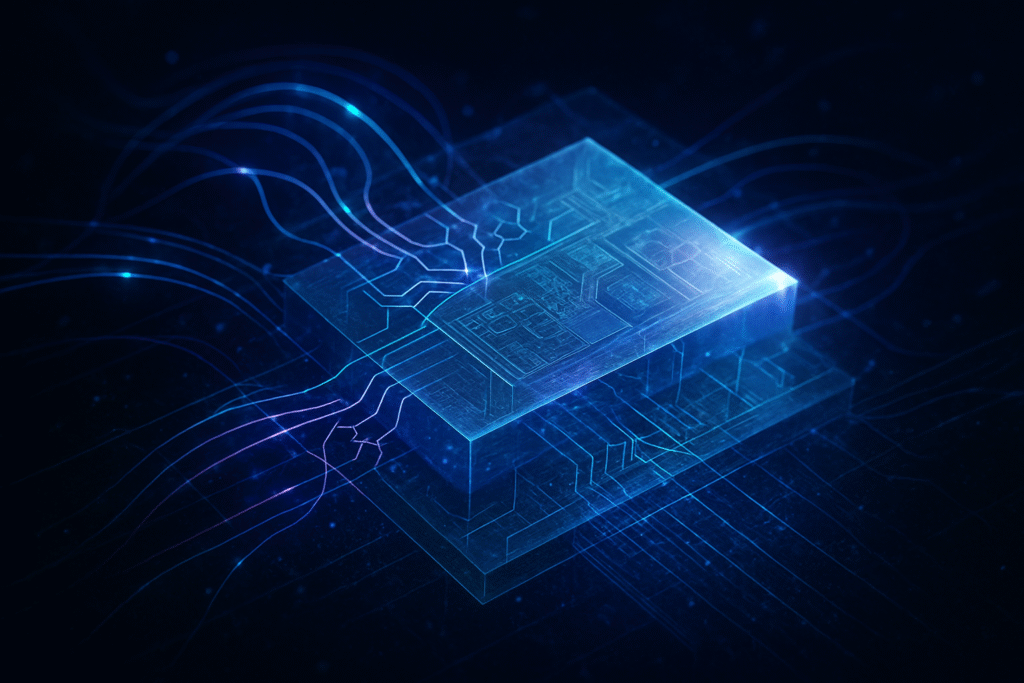
The semiconductor industry stands at the precipice of a transformative era, driven by groundbreaking advancements in photonics and materials science. As traditional silicon-based technologies approach their physical limits, innovations in harnessing light and developing novel materials are emerging as critical enablers for the next generation of computing, communication, and artificial intelligence (AI) systems. These developments promise not only to overcome current bottlenecks but also to unlock unprecedented levels of performance, energy efficiency, and manufacturing capabilities, fundamentally reshaping the landscape of high-tech industries.
This convergence of disciplines is poised to redefine what's possible in microelectronics. From ultra-fast optical interconnects that power hyperscale data centers to exotic two-dimensional materials enabling atomic-scale transistors and wide bandgap semiconductors revolutionizing power management, these fields are delivering the foundational technologies necessary to meet the insatiable demands of an increasingly data-intensive and AI-driven world. The immediate significance lies in their potential to dramatically accelerate data processing, reduce power consumption, and enable more compact and powerful devices across a myriad of applications.
The Technical Crucible: Light and Novel Structures Redefine Chip Architecture
The core of this revolution lies in specific technical breakthroughs that challenge the very fabric of conventional semiconductor design. Silicon Photonics (SiP) is leading the charge, integrating optical components directly onto silicon chips using established CMOS manufacturing processes. This allows for ultra-fast interconnects, supporting data transmission speeds exceeding 800 Gbps, which is vital for bandwidth-hungry applications in data centers, cloud infrastructure, and 5G/6G networks. Crucially, SiP offers superior energy efficiency compared to traditional electronic interconnects, significantly curbing the power consumption of massive computing infrastructures. The market for silicon photonics is experiencing robust growth, with projections estimating it could reach USD 9.65 billion by 2030, reflecting its pivotal role in future communication.
Further enhancing photonic integration, researchers have recently achieved a significant milestone with the development of the first electrically pumped continuous-wave semiconductor laser made entirely from Group IV elements (silicon-germanium-tin and germanium-tin) directly grown on a silicon wafer. This breakthrough addresses a long-standing challenge by paving the way for fully integrated photonic circuits without relying on off-chip light sources. Complementing this, Quantum Photonics is rapidly advancing, utilizing nano-sized semiconductor "quantum dots" as on-demand single-photon generators for quantum optical circuits. These innovations are fundamental for scalable quantum information processing, spanning secure communication, advanced sensing, and quantum computing, pushing beyond classical computing paradigms.
On the materials science front, 2D Materials like graphene, molybdenum disulfide (MoS2), and hexagonal Boron Nitride (h-BN) are emerging as formidable contenders to or complements for silicon. These atomically thin materials boast exceptional electrical and thermal conductivity, mechanical strength, flexibility, and tunable bandgaps, enabling the creation of atomic-thin channel transistors and monolithic 3D integration. This allows for further miniaturization beyond silicon's physical limits while also improving thermal management and energy efficiency. Major industry players such as Taiwan Semiconductor Manufacturing Company (TSMC) (TWSE: 2330), Intel Corporation (NASDAQ: INTC), and IMEC are heavily investing in research and integration of these materials, recognizing their potential to unlock unprecedented performance and density.
Another critical area is Wide Bandgap (WBG) Semiconductors, specifically Gallium Nitride (GaN) and Silicon Carbide (SiC). These materials offer superior performance over silicon, including higher breakdown voltages, improved thermal stability, and enhanced efficiency at high frequencies and power levels. They are indispensable for power electronics in electric vehicles, 5G infrastructure, renewable energy systems, and industrial machinery, contributing to extended battery life and reduced charging times. The global WBG semiconductor market is expanding rapidly, projected to grow from USD 2.13 billion in 2024 to USD 8.42 billion by 2034, underscoring their crucial role in modern power management. The integration of Artificial Intelligence (AI) in materials discovery and manufacturing processes further accelerates these advancements, with AI-driven simulation tools drastically reducing R&D cycles and optimizing design efficiency and yield in fabrication facilities for sub-2nm nodes.
Corporate Battlegrounds: Reshaping the AI and Semiconductor Landscape
The profound advancements in photonics and materials science are not merely technical curiosities; they are potent catalysts reshaping the competitive landscape for major AI companies, tech giants, and innovative startups. These innovations are critical for overcoming the limitations of current electronic systems, enabling the continued growth and scaling of AI, and will fundamentally redefine strategic advantages in the high-stakes world of AI hardware.
NVIDIA Corporation (NASDAQ: NVDA), a dominant force in AI GPUs, is aggressively adopting silicon photonics to supercharge its next-generation AI clusters. The company is transitioning from pluggable optical modules to co-packaged optics (CPO), integrating optical engines directly with switch ASICs, which is projected to yield a 3.5x improvement in power efficiency, a 64x boost in signal integrity, and tenfold enhanced network resiliency, drastically accelerating system deployment. NVIDIA's upcoming Quantum-X and Spectrum-X Photonics switches, slated for launch in 2026, will leverage CPO for InfiniBand and Ethernet networks to connect millions of GPUs. By embedding photonic switches into its GPU-centric ecosystem, NVIDIA aims to solidify its leadership in AI infrastructure, offering comprehensive solutions for the burgeoning "AI factories" and effectively addressing data transmission bottlenecks that plague large-scale AI deployments.
Intel Corporation (NASDAQ: INTC), a pioneer in silicon photonics, continues to invest heavily in this domain. It has introduced fully integrated optical compute interconnect (OCI) chiplets to revolutionize AI data transmission, boosting machine learning workload acceleration and mitigating electrical I/O limitations. Intel is also exploring optical neural networks (ONNs) with theoretical latency and power efficiency far exceeding traditional silicon designs. Intel’s ability to integrate indium phosphide-based lasers directly onto silicon chips at scale provides a significant advantage, positioning the company as a leader in energy-efficient AI at both the edge and in data centers, and intensifying its competition with NVIDIA and Advanced Micro Devices, Inc. (NASDAQ: AMD). However, the growing patent activity from Taiwan Semiconductor Manufacturing Company (TSMC) (TWSE: 2330) in silicon photonics suggests an escalating competitive dynamic.
Advanced Micro Devices, Inc. (NASDAQ: AMD) is making bold strategic moves into silicon photonics, notably through its acquisition of the startup Enosemi. Enosemi's expertise in photonic integrated circuits (PICs) will enable AMD to develop co-packaged optics solutions for faster, more efficient data movement within server racks, a critical requirement for ever-growing AI models. This acquisition strategically positions AMD to compete more effectively with NVIDIA by integrating photonics into its full-stack AI portfolio, encompassing CPUs, GPUs, FPGAs, networking, and software. AMD is also collaborating with partners to define an open photonic interface standard, aiming to prevent proprietary lock-in and enable scalable, high-bandwidth interconnects for AI and high-performance computing (HPC).
Meanwhile, tech giants like Google LLC (NASDAQ: GOOGL) and Microsoft Corporation (NASDAQ: MSFT) stand to benefit immensely from these advancements. As a major AI and cloud provider, Google's extensive use of AI for machine learning, natural language processing, and computer vision means it will be a primary customer for these advanced semiconductor technologies, leveraging them in its custom AI accelerators (like TPUs) and cloud infrastructure to offer superior AI services. Microsoft is actively researching and developing analog optical computers (AOCs) as a potential solution to AI’s growing energy crisis, with prototypes demonstrating up to 100 times greater energy efficiency for AI inference tasks than current GPUs. Such leadership in AOC development could furnish Microsoft with a unique, highly energy-efficient hardware platform, differentiating its Azure cloud services and potentially disrupting the dominance of existing GPU architectures.
Taiwan Semiconductor Manufacturing Company (TSMC) (TWSE: 2330), as the world's largest contract chipmaker, is a critical enabler of these advancements. TSMC is heavily investing in silicon photonics to boost performance and energy efficiency for AI applications, targeting production readiness by 2029. Its COUPE platform for co-packaged optics is central to NVIDIA's future AI accelerator designs, and TSMC is also aggressively advancing in 2D materials research. TSMC's leadership in advanced fabrication nodes (3nm, 2nm, 1.4nm) and its aggressive push in silicon photonics solidify its position as the leading foundry for AI chips, making its ability to integrate these complex innovations a key competitive differentiator for its clientele.
Beyond the giants, these innovations create fertile ground for emerging startups specializing in niche AI hardware, custom ASICs for specific AI tasks, or innovative cooling solutions. Companies like Lightmatter are developing optical chips that offer ultra-high speed, low latency, and low power consumption for HPC tasks. These startups act as vital innovation engines, developing specialized hardware that challenges traditional architectures and often become attractive acquisition targets for tech giants seeking to integrate cutting-edge photonics and materials science expertise, as exemplified by AMD's acquisition of Enosemi. The overall shift is towards heterogeneous integration, where diverse components like photonic and electronic elements are combined using advanced packaging, challenging traditional CPU-SRAM-DRAM architectures and giving rise to "AI factories" that demand a complete reinvention of networking infrastructure.
A New Era of Intelligence: Broader Implications and Societal Shifts
The integration of photonics and advanced materials science into semiconductor technology represents more than just an incremental upgrade; it signifies a fundamental paradigm shift with profound implications for the broader AI landscape and society at large. These innovations are not merely sustaining the current "AI supercycle" but are actively driving it, addressing the insatiable computational demands of generative AI and large language models (LLMs) while simultaneously opening doors to entirely new computing paradigms.
At its core, this hardware revolution is about overcoming the physical limitations that have begun to constrain traditional silicon-based chips. As transistors shrink, quantum tunneling effects and the "memory wall" bottleneck—the slow data transfer between processor and memory—become increasingly problematic. Photonics and novel materials directly tackle these issues by enabling faster data movement with significantly less energy and by offering alternative computing architectures. For instance, photonic AI accelerators promise two orders of magnitude speed increase and three orders of magnitude reduction in power consumption for certain AI tasks compared to electronic counterparts. This dramatic increase in energy efficiency is critical, as the energy consumption of AI data centers is a growing concern, projected to double by the end of the decade, aligning with broader trends towards green computing and sustainable AI development.
The societal impacts of these advancements are far-reaching. In healthcare, faster and more accurate AI will revolutionize diagnostics, enabling earlier disease detection (e.g., cancer) and personalized treatment plans based on genetic information. Wearable photonics with integrated AI functions could facilitate continuous health monitoring. In transportation, real-time, low-latency AI processing at the edge will enhance safety and responsiveness in autonomous systems like self-driving cars. For communication and data centers, silicon photonics will lead to higher density, performance, and energy efficiency, forming the backbone for the massive data demands of generative AI and LLMs. Furthermore, AI itself is accelerating the discovery of new materials with exotic properties for quantum computing, energy storage, and superconductors, promising to revolutionize various industries. By significantly reducing the energy footprint of AI, these advancements also contribute to environmental sustainability, mitigating concerns about carbon emissions from large-scale AI models.
However, this transformative period is not without its challenges and concerns. The increasing sophistication of AI, powered by this advanced hardware, raises questions about job displacement in industries with repetitive tasks and significant ethical considerations regarding surveillance, facial recognition, and autonomous decision-making. Ensuring that advanced AI systems remain accessible and affordable during this transition is crucial to prevent a widening technological gap. Supply chain vulnerabilities and geopolitical tensions are also exacerbated by the global race for advanced semiconductor technology, leading to increased national investments in domestic fabrication capabilities. Technical hurdles, such as seamlessly integrating photonics and electronics and ensuring computational precision for large ML models, also need to be overcome. The photonics industry faces a growing skills gap, which could delay innovation, and despite efficiency gains, the sheer growth in AI model complexity means that overall energy demands will remain a significant concern.
Comparing this era to previous AI milestones, the current hardware revolution is akin to, and in some ways surpasses, the transformative shift from CPU-only computing to GPU-accelerated AI. Just as GPUs propelled deep learning from an academic curiosity to a mainstream technology, these new architectures have the potential to spark another explosion of innovation, pushing AI into domains previously considered computationally infeasible. Unlike earlier AI milestones characterized primarily by algorithmic breakthroughs, the current phase is marked by the industrialization and scaling of AI, where specialized hardware is not just facilitating advancements but is often the primary bottleneck and key differentiator for progress. This shift signifies a move from simply optimizing existing architectures to fundamentally rethinking the very physics of computation for AI, ushering in a "post-transistor" era where AI not only consumes advanced chips but actively participates in their creation, optimizing chip design and manufacturing processes in a symbiotic "AI supercycle."
The Road Ahead: Future Developments and the Dawn of a New Computing Paradigm
The horizon for semiconductor technology, driven by photonics and advanced materials science, promises a "hardware renaissance" that will fundamentally redefine the capabilities of future intelligent systems. Both near-term and long-term developments point towards an era of unprecedented speed, energy efficiency, and novel computing architectures that will fuel the next wave of AI innovation.
In the near term (1-5 years), we can expect to see the early commercial deployment of photonic AI chips in data centers, particularly for specialized high-speed, low-power AI inference tasks. Companies like Lightmatter, Lightelligence, and Celestial AI are at the forefront of this, with prototypes already being tested by tech giants like Microsoft (NASDAQ: MSFT) in their cloud data centers. These chips, which use light pulses instead of electrical signals, offer significantly reduced energy consumption and higher data rates, directly addressing the growing energy demands of AI. Concurrently, advancements in advanced lithography, such as ASML's High-NA EUV system, are expected to enable 2nm and 1.4nm process nodes by 2025, leading to more powerful and efficient AI accelerators and CPUs. The increased integration of novel materials like 2D materials (e.g., graphene in optical microchips, consuming 80% less energy than silicon photonics) and ferroelectric materials for ultra-low power memory solutions will become more prevalent. Wide Bandgap (WBG) semiconductors like GaN and SiC will further solidify their indispensable role in energy-intensive AI data centers due to their superior properties. The industry will also witness a growing emphasis on heterogeneous integration and advanced packaging, moving away from monolithic scaling to combine diverse functionalities onto single, dense modules through strategic partnerships.
Looking further ahead into the long term (5-10+ years), the vision extends to a "post-silicon era" beyond 2027, with the widespread commercial integration of 2D materials for ultra-efficient transistors. The dream of all-optical compute and neuromorphic photonics—chips mimicking the human brain's structure and function—will continue to progress, offering ultra-efficient processing by utilizing phase-change materials for in-memory compute to eliminate the optical/electrical overhead of data movement. Miniaturization will reach new heights, with membrane-based nanophotonic technologies enabling tens of thousands of photonic components per chip, alongside optical modulators significantly smaller than current silicon-photonic devices. A profound prediction is the continuous, symbiotic evolution where AI tools will increasingly design their own chips, accelerate development, and even discover new materials, creating a "virtuous cycle of innovation." The fusion of quantum computing and AI could eventually lead to full quantum AI chips, significantly accelerating AI model training and potentially paving the way for Artificial General Intelligence (AGI). If cost and integration challenges are overcome, photonic AI chips may even influence consumer electronics, enabling powerful on-device AI in laptops or edge devices without the thermal constraints that plague current mobile processors.
These advancements will unlock a new generation of AI applications. High-performance AI will benefit from photonic chips for high-speed, low-power inference tasks in data centers, cloud environments, and supercomputing, drastically reducing operating expenses and latency for large language model queries. Real-time Edge AI will become more pervasive, enabling powerful, instantaneous AI processing on devices like smartphones and autonomous vehicles, without constant cloud connectivity. The massive computational power will supercharge scientific discovery in fields like astronomy and personalized medicine. Photonics will play a crucial role in communication infrastructure, supporting 6G and Terahertz (THz) communication technologies with high bandwidth and low power optical interconnects. Advanced robotics and autonomous systems will leverage neuromorphic photonic LSTMs for high-speed, high-bandwidth neural networks in time-series applications.
However, significant challenges remain. Manufacturing and integration complexity are considerable, from integrating novel materials into existing silicon processes to achieving scalable, high-volume production of photonic components and addressing packaging hurdles for high-density, heterogeneous integration. Performance and efficiency hurdles persist, requiring continuous innovation to reduce power consumption of optical interconnects while managing thermal output. The industry also faces an ecosystem and skills gap, with a shortage of skilled photonic engineers and a need for mature design tools and standardized IP comparable to electronics. Experts predict the AI chip market will reach $309 billion by 2030, with silicon photonics alone accounting for $7.86 billion, growing at a CAGR of 25.7%. The future points to a continuous convergence of materials science, advanced lithography, and advanced packaging, moving towards highly specialized AI hardware. AI itself will play a critical role in designing the next generation of semiconductors, fostering a "virtuous cycle of innovation," ultimately leading to AI becoming an invisible, intelligent layer deeply integrated into every facet of technology and society.
Conclusion: A New Dawn for AI, Forged by Light and Matter
As of October 20, 2025, the semiconductor industry is experiencing a profound transformation, driven by the synergistic advancements in photonics and materials science. This revolution is not merely an evolutionary step but a fundamental redefinition of the hardware foundation upon which artificial intelligence operates. By overcoming the inherent limitations of traditional silicon-based electronics, these fields are pushing the boundaries of computational power, energy efficiency, and scalability, essential for the increasingly complex AI workloads that define our present and future.
The key takeaways from this era are clear: a deep, symbiotic relationship exists between AI, photonics, and materials science. Photonics provides the means for faster, more energy-efficient hardware, while advanced materials enable the next generation of components. Crucially, AI itself is increasingly becoming a powerful tool to accelerate research and development within both photonics and materials science, creating a "virtuous circle" of innovation. These fields directly tackle the critical challenges facing AI's exponential growth—computational speed, energy consumption, and data transfer bottlenecks—offering pathways to scale AI to new levels of performance while promoting sustainability. This signifies a fundamental paradigm shift in computing, moving beyond traditional electronic computing paradigms towards optical computing, neuromorphic architectures, and heterogeneous integration with novel materials that are redefining how AI workloads are processed and trained.
In the annals of AI history, these innovations mark a pivotal moment, akin to the transformative rise of the GPU. They are not only enabling the exponential growth in AI model complexity and capability, fostering the development of ever more powerful generative AI and large language models, but also diversifying the AI hardware landscape. The sole reliance on traditional GPUs is evolving, with photonics and new materials enabling specialized AI accelerators, neuromorphic chips, and custom ASICs optimized for specific AI tasks, from training in hyperscale data centers to real-time inference at the edge. Effectively, these advancements are extending the spirit of Moore's Law, ensuring continued increases in computational power and efficiency through novel means, paving the way for AI to be integrated into a much broader array of devices and applications.
The long-term impact of photonics and materials science on AI will be nothing short of transformative. We can anticipate the emergence of truly sustainable AI, driven by the relentless focus on energy efficiency through photonic components and advanced materials, mitigating the growing energy consumption of AI data centers. AI will become even more ubiquitous and powerful, with advanced capabilities seamlessly embedded in everything from consumer electronics to critical infrastructure. This technological wave will continue to revolutionize industries such as healthcare (with photonic sensors for diagnostics and AI-powered analysis), telecommunications (enabling the massive data transmission needs of 5G/6G), and manufacturing (through optimized production processes). While challenges persist, including the high costs of new materials and advanced manufacturing, the complexity of integrating diverse photonic and electronic components, and the need for standardization, the ongoing "AI supercycle"—where AI advancements fuel demand for sophisticated semiconductors which, in turn, unlock new AI possibilities—promises a self-improving technological ecosystem.
What to watch for in the coming weeks and months (October 20, 2025): Keep a close eye on the limited commercial deployment of photonic accelerators in cloud environments by early 2026, as major tech companies test prototypes for AI model inference. Expect continued advancements in Co-Packaged Optics (CPO), with companies like TSMC (TWSE: 2330) pioneering platforms such as COUPE, and further industry consolidation through strategic acquisitions aimed at enhancing CPO capabilities. In materials science, monitor the rapid transition to next-generation process nodes like TSMC's 2nm (N2) process, expected in late 2025, leveraging Gate-All-Around FETs (GAAFETs). Significant developments in advanced packaging innovations, including 3D stacking and hybrid bonding, will become standard for high-performance AI chips. Watch for continued laboratory breakthroughs in 2D material progress and the increasing adoption and refinement of AI-driven materials discovery tools that accelerate the identification of new components for sub-3nm nodes. Finally, 2025 is considered a "breakthrough year" for neuromorphic chips, with devices from companies like Intel (NASDAQ: INTC) and IBM (NYSE: IBM) entering the market at scale, particularly for edge AI applications. The interplay between these key players and emerging startups will dictate the pace and direction of this exciting new era.
This content is intended for informational purposes only and represents analysis of current AI developments.
TokenRing AI delivers enterprise-grade solutions for multi-agent AI workflow orchestration, AI-powered development tools, and seamless remote collaboration platforms.
For more information, visit https://www.tokenring.ai/.







